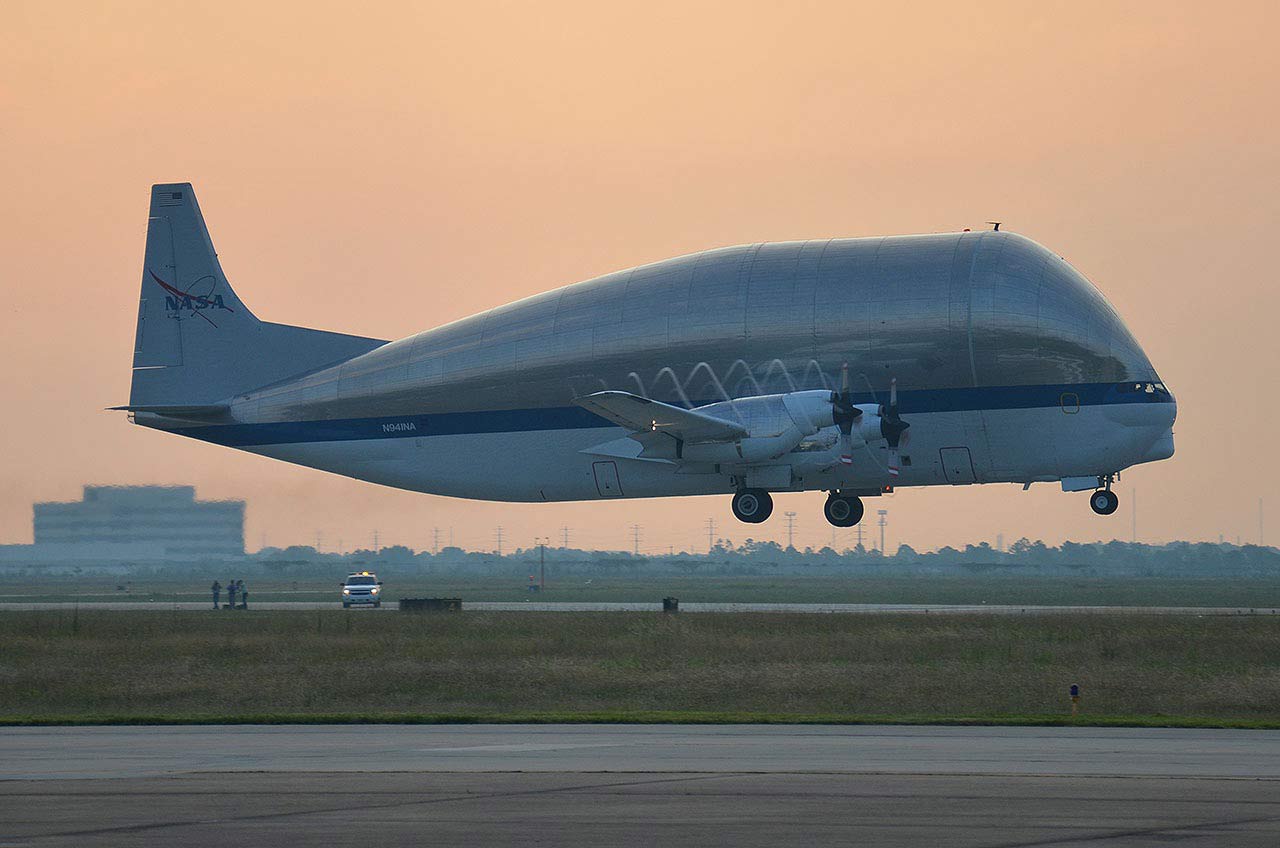Space Shuttle Trainer Lifts Off for Seattle on NASA Aircraft

This story was updated at 12:28 p.m. EDT.
A space shuttle crew cabin took off with a veteran astronaut on Wednesday morning (June 27), but rather than the shuttle lofting the pilot, it was the astronaut — flying a large NASA cargo plane — who was taking the shuttle trainer skyward.
Astronaut Greg C. Johnson, together with NASA pilot Dick Clark, left Ellington Field in Houston on board the Super Guppy, a wide-bodied turboprop aircraft previously used to deliver the room-size modules of the International Space Station to their Florida launch site.
Wednesday's cargo was the equally large crew cabin from the Full Fuselage Trainer (FFT), a life-size space shuttle mockup that was used by every person who flew on the shuttle while training at NASA's Johnson Space Center in Houston. The shuttle program now over, the FFT is being delivered in segmentsto The Museum of Flight in Seattle for its public display.
The 28-foot (8.5 meters) long compartment — comprising the shuttle's iconic nose with its dual level flight- and mid-decks — was loaded into the Super Guppy's 111-foot (34 meters) long cargo hold last Friday (June 22). The bulbous aircraft features a unique hinged nose that can open more than 200 degrees, allowing large items like the crew cabin to be loaded and unloaded from the front.
The shuttle cabin and cargo craft combo took off Monday for a short 20 minute test flight before leaving for Seattle on Wednesday. The Super Guppy's three-day, four-leg trip will take it from Texas to California and on to Washington.
Shuttlefest scheduled
The Super Guppy is scheduled to touch down at Seattle's Boeing Field at 11 a.m. PDT (2 p.m. EDT or 1800 GMT) on Saturday (June 30). The Museum of Flight will hold a public "Shuttlefest" celebrating the FFTcabin's arrival that morning.
Get the Space.com Newsletter
Breaking space news, the latest updates on rocket launches, skywatching events and more!
After remarks by Johnson, museum president and CEO Doug King and Washington Governor Christine Gregoire, among others, the public will be invited to watch as the shuttle crew cabin is offloaded from the Super Guppy and moved into the museum's Charles Simonyi Space Gallery, named after the Hungarian-born space tourist and billionaire software developer who funded it.
After all of the FFT's components are delivered to Seattle, the wingless shuttle mockup will be reassembled, nose to tail, in the Simonyi Gallery. The 15,500 square foot exhibit hall, which was originally built with a space-flown orbiter in mind, will be the centerpiece of a new permanent display opening this fall.
"Spaceflight Academy" will share the story of how shuttle astronauts trained for their flights and how the knowledge gained during the first 50 years of spaceflight has helped prepare humans to explore farther into the solar system. In addition to the FFT, the gallery displays its namesake's spacecraft, one of two Russian Soyuz that Simonyi flewon during his two self-funded trips to the space station.
Super shuttle
After the FFT crew cabin is offloaded, the public will get a chance to view the Super Guppy at The Museum of Flight. The plane will remain on display over the weekend before departing Seattle to return to Texas on Monday (July 2).
The Airbus-built Super Guppy is one of only five built, the only one still flying and the only one in NASA's fleet. It was acquired from the European Space Agency as part of a barter for flying experiments on two shuttle missions. It has been flying since 1983.
The Super Guppy however, is the latest version in a long line of Guppy cargo aircraft used by NASA. Past Guppys were used during the Gemini, Apollo and Skylab programs to transport spacecraft components.
collectSPACE.com will join the FFT in-flight on Thursday (June 28) as editor Robert Pearlman flies with its astronaut pilots on board the Super Guppy. Visit collectSPACE.com this week for exclusive reports and imagery from the space shuttle crew cabin's delivery flight.
Editor's note: This story was updated to correctly identify the astronauts flying NASA's Super Guppy aircraft.
Follow collectSPACE on Facebook and Twitter @collectSPACE and editor Robert Pearlman @robertpearlman. Copyright 2012 collectSPACE.com. All rights reserved.
Join our Space Forums to keep talking space on the latest missions, night sky and more! And if you have a news tip, correction or comment, let us know at: community@space.com.

Robert Pearlman is a space historian, journalist and the founder and editor of collectSPACE.com, a daily news publication and community devoted to space history with a particular focus on how and where space exploration intersects with pop culture. Pearlman is also a contributing writer for Space.com and co-author of "Space Stations: The Art, Science, and Reality of Working in Space” published by Smithsonian Books in 2018.In 2009, he was inducted into the U.S. Space Camp Hall of Fame in Huntsville, Alabama. In 2021, he was honored by the American Astronautical Society with the Ordway Award for Sustained Excellence in Spaceflight History. In 2023, the National Space Club Florida Committee recognized Pearlman with the Kolcum News and Communications Award for excellence in telling the space story along the Space Coast and throughout the world.










